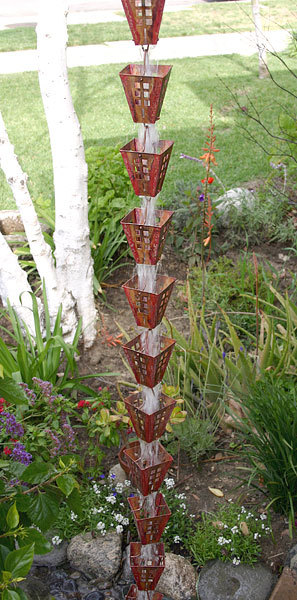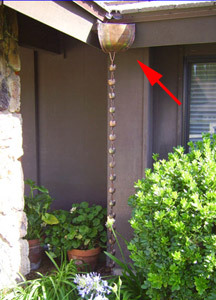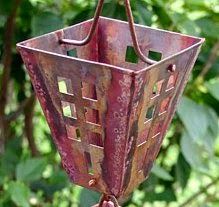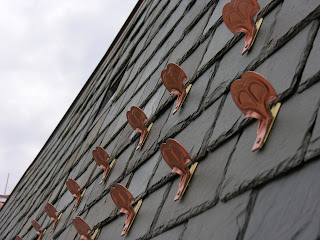Rain chains have become a lot more popular nowadays, mainly because they’re a low cost alternative to downspouts, which can look clunky and unattractive. If you have decided that you want to use a rain chain instead of spending a lot of cash on a downspout that you may not even like, you have a big decision ahead of you – will you take the time to build a rain chain on your own, or do you think that it may be a better idea for you to just buy one and install it on your home? Here are some considerations that you will want to make if you’re looking to use rain chains on your home.
Why Would I Build a Rain Chain?
There are a few reasons that you may want to think about building a rain chain instead of buying one. Here are some of the main reasons that you may want to do so.
First, if you’re the type that really likes to be creative, or if you enjoy tinkering and trying out new things that you can make, then you may want to try your hand at making a rain chain yourself instead of going out and buying one premade. Even if you’re not incredibly skilled at it, you may still be able to put it together quite easily because it’s not a hard task for you to take on. You may have to try a few times in order to be able to get the whole thing down and done correctly, but it’s worth the effort to save the cash.
If you’re crafty and you happen to have some metal laying around the house you may want to build your own rain chain. Since it is such an easy task and you already have the skills, you’re going to be in a much better place, and you’re not going to have a huge budget when it comes to putting the whole thing together. On top of that, you’re going to have a lot of fun and you won’t have to buy any tools in order to try and do the whole thing either.
Why Would I Just Buy a Rain Chain?
In other cases, you may be trying to figure out if buying a rain chain is the right decision. Here are some of the considerations that you may want to make if you’re just going to buy a rain chain.
What does your budget look like? There are many items that can make it a lot easier for you to get your costs under control. In some cases, especially if you don’t have any of the supplies that we talked about above, it may just be better for you to go out and buy one. This is the same case if you’ve decided that you want to save time, as well. Some people just don’t have the time that they need in order to be able to make something like a well done rain chain.
Another consideration is the design. Even though many people can make a basic chain that doesn’t have any frills, it takes a little bit more skill to make a more complicated one. If you’re looking for something elaborate or decorative then you may want to leave it to the processionals and take a look at everything that is already on the market. You may find something that you absolutely love and adore, or you may even find something that goes perfectly with the whole scheme that you have for the outside of your home. Either way, you at least want to go ahead and look at the premade ones that are out there.
If you’ve been looking at a rain chain, this is an important decision that you’re going to want to make so that you can figure out a budget and such ahead of time. If you’re looking for a rain chain, go ahead and check out the entire selection that we have available for you. There are a lot of beautiful ones that you can choose from, and they’re easy to install on your home at any point in time.
For more Information about Rain Chains visit us.
Source : Click here.
There are a few reasons that you may want to think about building a rain chain instead of buying one. Here are some of the main reasons that you may want to do so.
First, if you’re the type that really likes to be creative, or if you enjoy tinkering and trying out new things that you can make, then you may want to try your hand at making a rain chain yourself instead of going out and buying one premade. Even if you’re not incredibly skilled at it, you may still be able to put it together quite easily because it’s not a hard task for you to take on. You may have to try a few times in order to be able to get the whole thing down and done correctly, but it’s worth the effort to save the cash.
If you’re crafty and you happen to have some metal laying around the house you may want to build your own rain chain. Since it is such an easy task and you already have the skills, you’re going to be in a much better place, and you’re not going to have a huge budget when it comes to putting the whole thing together. On top of that, you’re going to have a lot of fun and you won’t have to buy any tools in order to try and do the whole thing either.
Why Would I Just Buy a Rain Chain?
In other cases, you may be trying to figure out if buying a rain chain is the right decision. Here are some of the considerations that you may want to make if you’re just going to buy a rain chain.
What does your budget look like? There are many items that can make it a lot easier for you to get your costs under control. In some cases, especially if you don’t have any of the supplies that we talked about above, it may just be better for you to go out and buy one. This is the same case if you’ve decided that you want to save time, as well. Some people just don’t have the time that they need in order to be able to make something like a well done rain chain.
Another consideration is the design. Even though many people can make a basic chain that doesn’t have any frills, it takes a little bit more skill to make a more complicated one. If you’re looking for something elaborate or decorative then you may want to leave it to the processionals and take a look at everything that is already on the market. You may find something that you absolutely love and adore, or you may even find something that goes perfectly with the whole scheme that you have for the outside of your home. Either way, you at least want to go ahead and look at the premade ones that are out there.
If you’ve been looking at a rain chain, this is an important decision that you’re going to want to make so that you can figure out a budget and such ahead of time. If you’re looking for a rain chain, go ahead and check out the entire selection that we have available for you. There are a lot of beautiful ones that you can choose from, and they’re easy to install on your home at any point in time.
For more Information about Rain Chains visit us.
Source : Click here.















